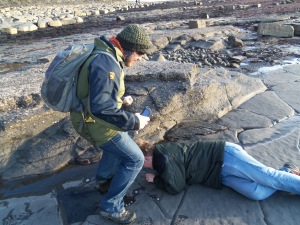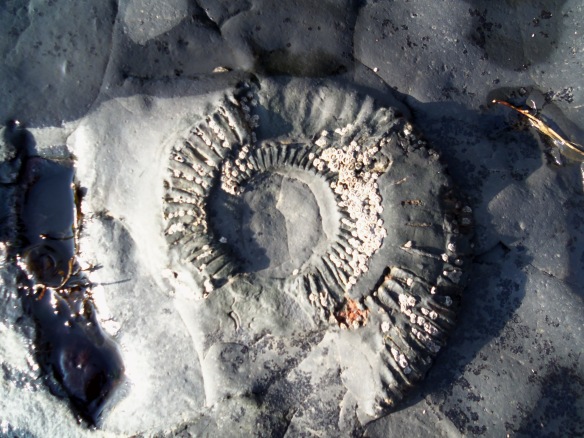Is it really the end of January? Where does the time go?
It is high time I updated you on the Ancient Anglers’ antics. We’ve been fishing, sort of.
A couple of weeks ago on a bright, sunny Sunday, with a very low tide on the way, I picked up Luke (and Steve, of Mesozoic monsters fame) from Southampton station and we headed off to Dorset to visit the Jurassic coast. I’d love to tell you we were there on serious scientific business at the cutting edge of palaeontology, but the truth is we were indulging our love of fossil hunting. The plan was to visit Chapman’s Pool, a remote location about 3 miles East of Kimmeridge Bay.
Figure 1 shows the view towards Chapman’s Pool from the top of the cliff. Unfortunately, I chose my cliff paths poorly, and the descent to the beach from where I took this photo would have been challenging to say the least! Rather than take the time to find the appropriate route to the beach, we decided to proceed to Kimmeridge Bay and park right next to the beach.
For those who don’t know this part of the world, the Dorset coast is a world heritage site with an almost complete succession of Jurassic strata exposed, getting younger as you move East. The area around Kimmeridge is late Jurassic and dates to between 155 and 150 million years ago. I won’t be speaking much of the geology in this post, but if you want to learn pretty much all there is to know about the geology and history of Kimmeridge (and many other areas) I highly recommend Dr. Ian West’s webpages.
http://www.southampton.ac.uk/~imw/Kimmeridge-Bay.htm
Dr. West has spent half a century exploring, cataloguing and studying most of the South coast and his webpages are filled with amazing photos and a wealth of information covering geology, palaeontology, petrology and local history.
Figure 2 shows the Kimmeridge Clay Formation looking East from Kimmeridge bay. Photo taken from the wave cut platforms which are exposed at low tide.
Since fossils were first discovered in the 19th Century at Kimmeridge, a huge diversity of prehistoric creatures has been found there. Dinosaurs, ichthyosaurs, plesiosaurs, pliosaurs and pterosaurs have all been found over the years. All very exciting and certainly of interest to us, but we were there for the fish!
Many genera of fish have been found at Kimmeridge including Aspidorhynchids, Coelacanths, Lepidotids, Pycnodonts, Thrissops and a host of other bony fish and sharks. Remains vary from isolated bones and teeth to exquisitely preserved partial and entire skeletons.
Figure 3 below shows one of the waterfalls that periodically adorn certain sections of cliff. One in particular was quite tricky to get past and is a cut-off point as the tide rises. The dark grey steps at the bottom are covered at high tide and this is a location where getting cut off is a real risk, so careful observations of tide and time is necessary. I include it here as I think it makes a nice photo!
Figure 4 was taken around one of the headlands looking West. Luke is waving in the distance. The entire area is underwater at high tide so we were trying to cover as much ground as possible in the available time. As well as searching for the more exciting (and predictably rare) fossils, there are some lovely ammonites preserved in the wave cut platforms. They cannot be collected as they are part of the platform, but some are very large and others well preserved. Here are a couple of examples we found (Figures 5 and 6.)
To be honest, as you search for the characteristic black and brown glint of bone, it is easy to become blasé about the sheer number of ammonites that are there. It’s easy to forget that these once living animals had to die, be buried and fossilised, and their remains survive for 150 million years, and then be exposed and then not be destroyed by erosion for us to be looking at them.
“Ammonite, ammonite, ammonite, big ammonite…” We stopped taking pictures of them quite quickly! (I’ve been on several field trips where finding even one ammonite would have made the day!) As I said earlier we were there for the fish, and they are relatively rare.
It is here that I wish I could insert a genuine “David Attenborough moment”, unveiling a spectacular discovery, as experienced by Steve a few months ago when he picked up a piece of rock in a quarry, telling us that this is exactly the sort of piece you might expect to find a tooth on, then turn it over to reveal a tooth!! I hope he blogged about that, it was a great moment, but I digress. As well as prospecting, we were there to investigate something I had found on a recent previous trip.
Figure 5 shows a barnacle encrusted ammonite in the platform.
Figure 6 shows an impression of an ammonite, crushed flat.
Not very far East of the car park at Kimmeridge bay, about 7m from the cliff on a section of platform I found a collection of bones! It appeared to be the disarticulated remains of a partial skeleton of an individual animal! To say I was excited was an understatement. One of the reasons I love fossil hunting is the thrill of “treasure” hunting and to me that is the very definition of treasure.
The problem I had was that it didn’t seem to fit anything I’d personally seen before. Some of the bones had a definite fishy sort of look (highly scientific, I know) but the straight bones were a confusing shape to me, and with the degree of weathering it was not immediately apparent what these bones are. So I thought it prudent to bring in some more learned fellows than I to have a look and try and identify what I’d found.
I’m pleased to report that they took the task very seriously.

After we stopped messing about, we quickly eliminated most of the possibilities, and concluded it had to be a fish of some sort, but the section of 7 vertebrae, much smaller than the other bones, must have come from another fish, preserved at the same time. On top of that, it definitely wasn’t a coelacanth, or (unsurprisingly) any of the Palaeozoic fishes that Luke studies. From the size of the bones we knew it had to be a fairly large fish, as no small fish has straight bones that large, but we had no further ideas at the time.
I include a couple of close up shots to highlight both the find itself and the difficulty in finding diagnostic bones in certain fossil assemblages. More photos are available on request.
As a significant collection of bones found in Kimmeridge bay is rare, it is important that these finds are reported. I had a fairly big clue that I was not the first person to find these bones. A 30 x 30cm (approx.) section had been buzz sawed out of the platform right next to my find, and there is only one person legally able to do this. I raised the subject when I was taking some photos of the coelacanths he found that I am studying.
Turns out my “awesome” exciting find is not museum worthy. It is a fish, it is rare, but it is not well enough preserved and not enough of it is preserved to excavate given the expense of so doing. As can be seen from the photos it is very weathered.
It has been identified as a large Pycnodont.
These are a group of fish that had dentition well adapted to crushing shells and came in a variety of sizes and body forms. A lot of them were laterally compressed and oval or circular in outline. This one was clearly a big one!
Whilst I am disappointed I didn’t find something museum worthy, I am pleased to note something that not everyone gets to see. In a few tides’ time (1-5 years at most) this will be gone forever. I encourage all of you that have an opportunity to visit the area to have a look, take some snaps. Here is a shot of the cliff directly opposite the bones.
The two cut out bits at the bottom of the cliff are quite distinctive.
All in all, it was a very enjoyable day. We prospected as far as we dared whilst the tide was low, saw some nice fossils and began and ended our trip looking at the best fossils I’ve ever found in the Jurassic. And it was a fish, so technically we were fishing, and we caught one!
That’s about all from me for this post. I’ll be in touch soon.
Chris











